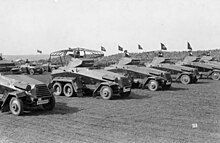Military parade on the Großenengliser Platte
The military parade on the Großenengliser Platte on September 18, 1936 was part of the armament of the Wehrmacht and served as preparation for mobilization in the German Reich . The parade between Großenenglis (today district of Borken ) and Udenborn (today district of Wabern ) was the largest military parade of equipment types in the Schwalm-Eder district after the First World War and at the same time a demonstration of power by the National Socialists in Europe. Its political importance was underlined by the presence of Adolf Hitler .
Preparations
The military parade was followed by autumn exercises and maneuvers of the IX. Army corps south of Fritzlar and in the greater Homberg area ahead. For this purpose, troop units were also relocated from other areas to northern Hesse and billeted there. Marching soldiers, detectors on bicycles and motorbikes and villages decorated with garlands and banners got the population in the mood for the parade.
Numerous interested people followed from specially designated observation posts, such as the Mosenberg near Homberg, from September 16 to 17, 1936 combat exercises of the troops divided into red and blue . The Mosenberg itself was "fought over" hard.
The greatest organizational effort was made for the parade. Weeks beforehand, detailed plans were drawn up and the construction of the two large wooden stands, each of which could accommodate 16,000 admitting visitors, began. In addition, the safety of high-ranking guests from the party and the army had to be guaranteed. There were precise instructions on how to behave for the audience. For example, it was forbidden to throw flowers in the passing cars of the national giants. It was strictly forbidden to take photos of the weapons on display, so that foreign military personnel would not have any insight into or knowledge of the latest types of equipment.
parade

On Friday, September 18, 1936, the visitors came to the destination area in buses and special trains early in the morning. The last train arrived at 9:31 a.m. For spectators who came with their own vehicle, there were large diversions. At the start of the military parade, both stands were sold out and thousands of visitors stood next to them for free.
The Gauleiter of Kurhessen, Karl Weinrich , and Oberpräsident Philipp Prinz von Hessen took their places in the stands. Adolf Hitler, who had previously held a military parade in the Würzburg area , came from the Zennern train station to Paradeplatz, first walked off an honorary company and handed over flags and standards . Then he turned to the soldiers: “You will stand by these flags in good and bad days. You will never leave them and carry them in your fists before the nation has grown up again. She looks at you with the greatest pride and blind trust. Prove yourself worthy of this trust and always put all your thoughts and actions under the heading of Germany ”. The Commander in Chief of the Army , Colonel General Werner von Fritsch , thanked Hitler on behalf of the soldiers with the words: “The army is proud and happy to have received the new flags from the hands of the man who pulled Germany back from the abyss, who brought all of Germany with it nationalistic and soldierly spirit ”.
Numerous music corps followed , some of which were mounted, infantry divisions, cavalry regiments, artillery units, communications and motorized troops with armored cars. The conclusion was formed by a squadron that flew over the Großenengliser Platte at a low altitude. Before Hitler to the nearby air base was brought Fritzlar, where he with a Ju 52 flew off he went with cheers and cheers again in the car standing slowly to the bleachers over.
literature
- Thomas Schattner: Parade: The Nazi power very close . Hessisch-Niedersächsische Allgemeine (HNA) , No. 217, September 18, 2001
- Karl Ernst Demandt : History of the State of Hesse . Stauda Verlag, Kassel, 1981
- Eduard Brauns: Hiking and travel guide through North Hesse and Waldeck , A. Bernecker Verlag, Melsungen, 1971, p. 19
Web links
Coordinates: 51 ° 5 ′ 43 ″ N , 9 ° 18 ′ 2 ″ E